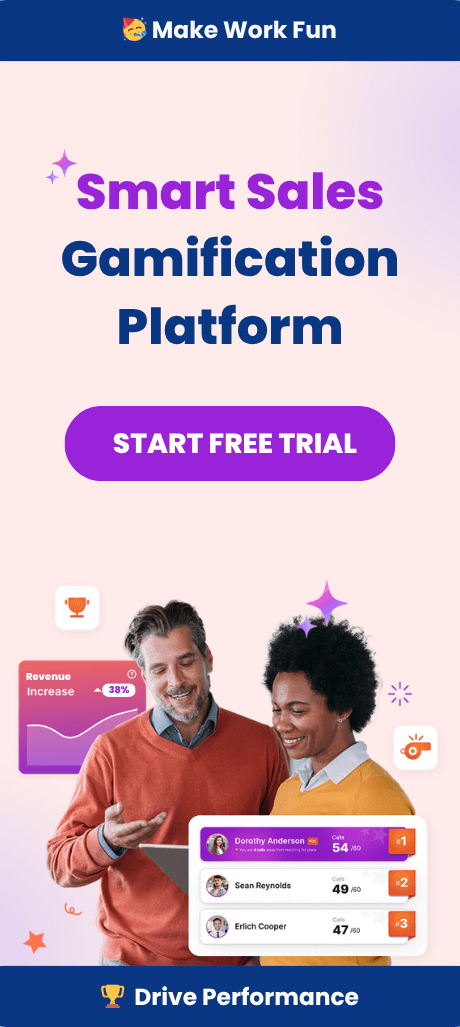Sales enablement is undergoing a transformation, and sales professionals everywhere are asking: Does gamification for sales enablement actually work? With companies like Salesforce, LinkedIn, and Microsoft experimenting with gamified sales training, it’s clear that sales gamification is more than just a passing trend. In this comprehensive guide, we’ll explore why gamified sales training works, how it transforms existing sales training programs, and how you can leverage it for better sales performance.
The Shift from Traditional Sales Training
Traditional training methods often rely on lengthy presentations and static e-learning modules that fail to engage sales reps effectively. These outdated approaches can lead to low training completion rates and poor knowledge retention, leaving sales teams unprepared for real-world challenges. Traditional methods frequently result in skill gaps, as sales reps do not fully develop or retain essential skills—gamification helps address these skill gaps by making training more engaging and effective. Sales reps today demand more interactive and dynamic experiences that not only teach skills but also keep them motivated and invested in their development.
By incorporating gamification in sales, companies can transform these conventional methods into engaging learning journeys. Interactive elements like quizzes, challenges, and rewards make training sessions more enjoyable and memorable, encouraging reps to participate actively and retain critical information. This shift ensures that training remains relevant and impactful in a fast-paced sales environment.
The Psychology Behind Sales Gamification
Sales gamification leverages innate human psychology by tapping into both intrinsic and extrinsic motivation. Sales gamification is specifically designed to leverage innate human psychology to motivate and engage sales reps, using principles like operant conditioning and positive reinforcement to drive repeated behaviors and improve performance. Intrinsic motivation drives reps through personal satisfaction and mastery, while extrinsic motivation uses tangible rewards like points, badges, and recognition to encourage desired behaviors. By incorporating these gamification mechanics, training becomes a compelling experience that motivates reps to engage consistently and strive for excellence.

Positive reinforcement plays a crucial role in this process. When sales reps receive immediate feedback and rewards for their achievements, their brains release dopamine, creating a cycle of motivation and continuous learning. This psychological foundation makes gamified sales training a powerful tool to improve performance and foster long-term skill development.
Why Gamified Sales Training Engages Learners
Gamified sales training transforms the learning process into a fun, competitive, and goal-oriented experience. Gamified sales training is specifically designed to drive engagement among sales reps by making learning more interactive and motivating. By incorporating game-like elements such as leaderboards and virtual rewards, sales reps are encouraged to challenge themselves and their peers, boosting engagement and participation. This interactive approach helps maintain high training completion rates and keeps reps invested in their skill development.
Moreover, gamification promotes active learning by encouraging reps to apply new knowledge in realistic scenarios. This hands-on practice enhances retention and builds confidence, enabling reps to perform better in real sales situations. Ultimately, gamified training not only makes learning enjoyable but also drives measurable improvements in sales success.
Sales Gamification Tools That Drive Results

Companies like Salesforce and SAP have integrated sales gamification tools into their enablement platforms, revolutionizing how sales reps engage with training. These tools provide real-time feedback, track progress, and reward achievements, making it easier for reps to stay motivated and focused on hitting key milestones. A gamification platform can centralize these features, offering a dashboard to track performance, foster healthy competition, and motivate teams or individuals through point-based rewards and prizes. By reinforcing positive behaviors, gamification tools help build lasting habits that translate into improved sales performance and higher revenue.
Moreover, these platforms offer advanced analytics that give sales managers valuable insights into individual and team progress. This data-driven approach enables targeted coaching and personalized development plans, ensuring that every rep receives the support they need to excel in a competitive sales environment.
Turning Sales Training into a Game
Game mechanics such as levels, challenges, and rewards transform sales training from a mundane task into an exciting journey. By leveraging various gamification techniques, organizations can create immersive and effective sales training experiences that drive motivation and engagement. Companies like Google use “quests” and interactive modules that encourage continuous learning and skill development, making training feel less like work and more like play. This approach not only boosts engagement but also helps reps absorb content more effectively through active participation.

Additionally, gamified training fosters adaptive learning paths, allowing reps to progress at their own pace and focus on areas where they need improvement. This personalized experience keeps learners motivated, helping them build confidence and master the skills necessary to succeed in today’s fast-paced sales process.
Healthy Competition Fuels Performance
Healthy competition is a hallmark of effective sales teams, and gamified training leverages this natural drive to boost performance. By incorporating sales leaderboards and team-based challenges, reps are motivated to outperform their peers in a fun and supportive environment. Gamification is also highly effective at encouraging teamwork by introducing collaborative challenges and shared rewards that foster collective effort. This friendly rivalry increases sales productivity while fostering camaraderie and teamwork.
Furthermore, gamification encourages teamwork by promoting collaborative challenges that require reps to work together toward shared business goals. This not only strengthens relationships within the team but also aligns individual efforts with organizational objectives, creating a culture where everyone is invested in collective success.
Continuous Learning: The Secret to Sales Success
Sales is an ever-evolving profession, and continuous learning is essential to staying ahead. Gamification encourages ongoing development by making training an engaging, repeatable experience that keeps sales skills sharp long after onboarding. Interactive challenges and real-time feedback help reps apply new knowledge immediately, reinforcing learning through practice.
This commitment to continuous learning also supports professional development by providing adaptive learning paths tailored to each rep’s needs. As a result, sales teams remain agile and prepared to navigate changing market conditions, driving sustained sales success and long-term growth.
Making Learning Measurable
A well-designed gamification strategy empowers sales managers to track progress through specific key performance indicators (KPIs), providing clear visibility into each rep’s development. A well-structured training program can leverage gamification to track and improve learning outcomes, ensuring that learning is both engaging and effective. This data-driven approach enables managers to identify knowledge gaps swiftly and tailor ongoing learning experiences to address individual and team needs. Real-time insights foster accountability and ensure training efforts align closely with business goals.
Moreover, measurable learning outcomes motivate sales reps by showing tangible progress and achievements. When reps see their growth quantified, it increases their commitment to continuous learning and improvement, creating a culture where development is both recognized and rewarded.
Building Team Cohesion with Gamified Sales
LinkedIn’s use of team-based competitions illustrates how gamified sales activities can strengthen relationships by uniting team members around shared objectives. These friendly contests encourage collaboration and communication, fostering a sense of belonging and mutual support. When teams work toward common goals, trust and camaraderie naturally flourish.
Beyond competition, gamification promotes knowledge sharing and collective problem-solving, helping teams overcome challenges together. This collaborative environment not only boosts morale but also aligns individual efforts with broader business objectives, enhancing overall sales effectiveness.
Motivation: More Than Just Money

Sales gamification taps into both intrinsic and extrinsic motivators to engage reps on multiple levels. Intrinsic rewards like personal pride and mastery fuel internal satisfaction, while extrinsic rewards such as points, badges, and public recognition provide tangible incentives. This balanced approach ensures that all types of motivation are addressed, making training programs more inclusive and effective.
By appealing to diverse motivational drivers, gamification keeps sales reps invested in their growth beyond financial incentives. It creates a dynamic learning environment where reps are encouraged to push their limits, fostering long-term engagement and sustained performance improvements.
Customizing the Gamification Program
No two sales teams operate the same way, which is why customization is key to a successful gamification program. Integrating gamification into sales training programs is essential to ensure alignment with broader business goals. Integrating gamification into existing workflows and technology infrastructure can significantly boost employee engagement, motivation, and overall sales performance. Companies like HubSpot tailor their gamification strategies to fit unique team cultures, ensuring that the game mechanics resonate with reps’ preferences and work styles. This personalized approach drives higher buy-in and participation.
Customization also allows organizations to align gamification elements with specific business goals and sales workflows. By adapting challenges, rewards, and feedback to meet team needs, companies create a flexible, engaging training experience that evolves alongside their sales force.
Sales Gamification Ideas for Modern Teams
Simple ideas—such as digital badges for completed courses or leaderboards for most improved—can revolutionize existing sales training programs without requiring major overhauls. Sales contests can also be incorporated as part of gamification ideas to motivate and engage sales teams, track performance, and incentivize productivity. These small but impactful gamification elements create visible milestones that motivate sales reps to push further. By celebrating progress in real time, reps feel a sense of accomplishment that fuels ongoing participation and healthy competition among peers.
Incorporating these gamification ideas into your sales training strategy encourages daily engagement and makes learning an enjoyable part of the sales routine. Even minimal changes can transform the training experience, fostering a culture where continuous improvement and recognition go hand in hand, driving better sales results overall.
From Theory to Real Results
Research from Deloitte shows that gamified training can increase engagement by over 50%. This boost in engagement translates directly into measurable improvements in sales performance, as motivated reps absorb and apply knowledge more effectively. Companies embracing gamification report higher training completion rates and stronger skill retention, leading to increased revenue and customer satisfaction.
Beyond numbers, gamified programs also enhance team morale by making learning interactive and rewarding. When reps see tangible benefits from their efforts, they become more invested in their development, creating a positive feedback loop that drives sustained sales success and empowers sales leaders to cultivate high-performing teams.
Making Feedback Instant and Actionable
One advantage of gamification is immediate feedback. Sales reps know where they stand, what they’ve mastered, and what skills still need attention, keeping the learning process transparent. This real-time insight allows reps to adjust their approach quickly, focusing on areas that will have the greatest impact on their performance.
Instant feedback also empowers sales managers to provide timely coaching tailored to individual needs. By using gamification platforms that highlight strengths and weaknesses, managers can guide reps more effectively, ensuring continuous skill development and fostering a growth mindset that keeps the team agile and competitive.
Encouraging Peer-to-Peer Learning
Sales gamification isn’t just top-down. Microsoft, for example, promotes knowledge-sharing by rewarding reps who help peers—fostering a culture of continuous learning. This approach builds stronger teams by encouraging collaboration and mutual support, turning training into a shared journey rather than an isolated task.
Peer-to-peer learning also accelerates skill development by leveraging diverse experiences within the team. When reps teach and learn from each other through gamified challenges, they deepen their understanding and build lasting relationships that enhance overall sales productivity and create a more connected sales environment.
Overcoming Boredom in Sales Training
Traditional sales training can feel monotonous. Gamified sales training introduces excitement, ensuring reps look forward to training days, not dread them. By adding interactive challenges, rewards, and competition, training becomes a dynamic experience that captures attention and sustains motivation.
This refreshing approach breaks the cycle of disengagement common in conventional programs. When learning feels fun and rewarding, reps are more likely to participate actively, retain knowledge longer, and apply skills confidently in real sales situations. Incorporating real world scenarios into gamified training allows learners to practice and test their knowledge in practical settings, enhancing retention and skill transfer—ultimately driving better sales outcomes for the organization.
Tracking Progress for Real Accountability
With sales gamification tools, sales managers gain clear, real-time visibility into each rep’s progress, enabling them to identify strengths and areas needing improvement quickly. This transparency fosters a culture of accountability, where reps understand their performance relative to goals and peers. Managers can provide timely, personalized coaching that drives meaningful skill development and boosts overall team productivity.
Moreover, tracking progress through gamification motivates sales reps to stay engaged and committed to their growth. Seeing tangible progress and achievements encourages reps to push harder, creating a positive feedback loop that fuels continuous learning and consistent performance improvements across the sales organization.
Gamification for Remote and Hybrid Teams
In today’s evolving work landscape, remote and hybrid sales teams face unique challenges in staying connected and motivated. Gamified training programs bridge this gap by offering interactive, engaging experiences accessible from anywhere, fostering a sense of community despite physical distance. This approach keeps reps energized, focused, and aligned with team goals regardless of location.
Additionally, gamification promotes collaboration and healthy competition among remote teams, helping to build camaraderie and shared purpose. By integrating game mechanics like leaderboards and team challenges, organizations ensure that remote sales reps remain motivated, productive, and connected to the broader sales enablement strategy.
Driving Better Adoption of Sales Enablement Tools
Adopting new sales enablement tools can be daunting for reps, often leading to resistance or low usage. Gamification transforms this process by turning tool adoption into an engaging challenge where reps earn points and rewards for consistent use. This approach reduces friction, making learning new systems enjoyable rather than burdensome.
Furthermore, gamified adoption encourages reps to explore and utilize the full capabilities of enablement tools, maximizing their impact on sales performance. By rewarding engagement, companies foster a culture where technology becomes a valued asset that supports reps in achieving their sales goals more efficiently.
Measuring ROI on Sales Training Gamification
The return on investment for gamified sales training is evident through increased sales productivity, enhanced skills, and elevated employee engagement. However, poorly executed gamification can lead to disengagement and reduce the effectiveness of the training program, ultimately undermining ROI. These improvements translate directly into higher revenue and reduced training costs, making gamification a cost-effective strategy for sales enablement.
Beyond financial gains, gamification drives intangible benefits like improved morale and stronger team dynamics. Organizations that measure ROI on gamified training can fine-tune their programs with data-driven insights, ensuring sustained success and continuous optimization of their sales training strategy.
Practical Steps for Implementing Sales Gamification
To successfully implement sales gamification, start by defining clear goals and specific key performance indicators (KPIs) that align with your business objectives. When implementing gamification, it is crucial to follow a structured, step-by-step approach to effectively integrate game-like elements into your existing sales training programs and maximize engagement. This clarity ensures your gamification efforts drive meaningful results. Begin with pilot programs featuring simple gamification ideas—like leaderboards, badges, or mini-challenges—to test engagement and gather valuable feedback from your sales team. Their input helps refine the program before a full-scale rollout, increasing buy-in and effectiveness.
Consistent communication and training are essential to keep reps motivated and informed. Encourage managers to celebrate milestones and recognize top performers regularly, fostering a positive competitive environment. By iterating based on feedback and performance data, your gamification program becomes a dynamic tool that continuously adapts to your team’s evolving needs, driving sustained sales productivity and engagement.
The Future of Sales Training Programs
The future of sales training is set to be more immersive and personalized than ever before. Emerging technologies like virtual reality (VR) will create lifelike sales scenarios, allowing reps to practice skills in realistic environments without real-world risks. Meanwhile, AI-driven game mechanics will tailor training paths to individual learning styles and performance, ensuring reps focus on areas where they need the most improvement, accelerating skill mastery.
These advancements will also enable real-time analytics and adaptive challenges that respond dynamically to reps’ progress. As gamification evolves, it will seamlessly integrate with CRM and sales enablement platforms, making continuous learning a natural part of daily workflows. This tech-driven future promises to empower sales teams with engaging, effective training that keeps pace with the fast-moving sales landscape.
Sales Enablement Success Stories
Cisco’s global “Sales Champion” challenges demonstrate how gamification can transform sales enablement on a massive scale. By turning training into a competitive and rewarding experience, Cisco boosted engagement across its worldwide sales force. New hires onboarded faster and felt more confident, leading to improved sales performance and stronger team cohesion. The program’s success highlights how gamification can make learning enjoyable while driving measurable business outcomes.
Other companies have followed suit, leveraging gamified sales training to increase retention and motivation. These success stories prove that when gamification is thoughtfully integrated into sales enablement, it not only enhances skills but also fosters a culture of continuous improvement and achievement. Such programs empower sales reps to reach their full potential, benefiting both individuals and organizations.
The Spinify Advantage
Spinify simplifies the process of implementing sales gamification with its user-friendly platform packed with customizable game mechanics. Sales managers can effortlessly create engaging contests, set specific KPIs, and track real-time progress through visually appealing dashboards. This ease of use ensures that gamification programs launch quickly and run smoothly without overwhelming teams or requiring extensive training.

Beyond setup, Spinify fosters ongoing motivation by providing instant feedback and celebrating achievements, helping reps stay focused and driven. Its flexibility allows companies to tailor gamification to their unique sales processes and company culture, making it a versatile solution. With Spinify, organizations can unlock the full potential of gamification to boost sales productivity, engagement, and overall success.
Unlock Your Team’s Potential
Gamification for sales enablement works—and it works effectively. By transforming traditional sales training into an engaging, motivating experience, you can supercharge sales success and create a culture of continuous learning.
Ready to level up your sales training strategy? Try Spinify today and discover how gamification can revolutionize your sales enablement!




